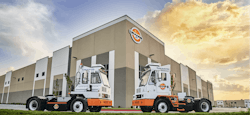CTL Deploying Orange EV Yard Trucks to Food Distribution Customers Across US
Commercial Trailer Leasing (CTL) has partnered with Orange EV to deploy pure-electric, zero-emission, DOT-compliant yard trucks throughout the US. The e-TRIEVER yard trucks will be paired with onsite charging cabinets and will be leased to various customers within the food distribution and logistics industries.
The e-TRIEVER trucks feature an 81,000-pound gross combined vehicle weight rating and are capable of handling harsh conditions and heavy-duty cycles with a functional environmental temperature range of -40°F to 120°F with an average uptime of 98%.
By electrifying the terminal truck industry, fleets can see savings of $20,000 to $90,000 per truck annually through fuel cost reduction, emission control elimination, and powertrain and brake maintenance cost reductions.
Orange EV also notes that fleets can reduce downtime and operator turnover costs due to safer working environments produced with EV yard trucks while meeting or exceeding company sustainability goals.
“We are proud to partner with CTL, a company helping its customers not only meet and exceed their sustainability goals, but also reduce operating costs and provide a safer and cleaner working environment,” said Kurt Neutgens, President and CTO of Orange EV.
About the Author
EnergyTech Staff
Rod Walton is head of content for EnergyTech.com. He has spent 17 years covering the energy industry as a newspaper and trade journalist.
Walton formerly was energy writer and business editor at the Tulsa World. Later, he spent six years covering the electricity power sector for Pennwell and Clarion Events. He joined Endeavor and EnergyTech in November 2021.
He can be reached at [email protected].
EnergyTech is focused on the mission critical and large-scale energy users and their sustainability and resiliency goals. These include the commercial and industrial sectors, as well as the military, universities, data centers and microgrids.
Many large-scale energy users such as Fortune 500 companies, and mission-critical users such as military bases, universities, healthcare facilities, public safety and data centers, shifting their energy priorities to reach net-zero carbon goals within the coming decades. These include plans for renewable energy power purchase agreements, but also on-site resiliency projects such as microgrids, combined heat and power, rooftop solar, energy storage, digitalization and building efficiency upgrades.
